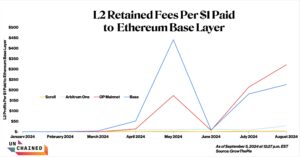L2s not paying large sums of ETH for rent in comparison to the amount of fees they retain has sparked an ongoing conversation in the crypto ecosystem, including Solana community members.
On Monday via X, Solana’s co-founder Anatoly Yakovenko said, “[L2s] are parasitic when they take more priority [transactions] from the base layer than they add.”
On the other hand, some, especially those in the Ethereum ecosystem, have said the impacts were part of the design to decrease transaction costs for users. For instance, on Thursday, Ethereum Foundation developer Dankrad Feist, in an Ethereum Foundation AMA, posted to Reddit saying, he didn’t believe rollups “might ultimately be parasitic.”
“The highest-value transactions will happen on Ethereum, while rollups will grow the pie by providing plenty of space for users to transact on Ethereum,” he wrote. “The relationship will be symbiotic: Ethereum provides rollups with cheap data availability and in return they make Ethereum L1 the natural crossroads for all financial activity for the really valuable transactions.”
Read More: Ether Has Been a Much Worse Investment Than Both Gold and Silver So Far This Year
Using data from layer 2 analytics platform GrowThePie, Unchained has calculated that, of the total fees crypto users pay to transact on Ethereum L2s, the vast majority of it does not accrue to Ethereum’s base layer.
While some have argued the definition of whether an L2 is parasitic or not depends on whether it takes away fees, revenue, and users from its L1, those participating in the debate have not drawn a specific threshold for what counts as parasitic.
However, ever since March’s Dencun upgrade, which made transacting cheaper on Layer 2s, the monetary supply of ETH has been more inflationary than deflationary. For instance, the supply of ETH has increased by 262,493.37 ETH worth about $621.6 million since April 3, three weeks after the Dencun upgrade, according to ETH supply analytics platform ultrasound.money.
L2s Retain Fees Often Hundreds of Times the Amount Sent to Ethereum L1
With the data from GrowThePie, Unchained calculated the retained fees of Scroll, Arbitrum One, OP Mainnet, and Base for every $1 expense connected to posting L2 transaction data and proofs onto Ethereum’s base layer.
In August, OP Mainnet led the pack, retaining $321.31 for every $1 expense to leverage the security of Ethereum’s base layer. Coinbase-incubated Base came in second place with $226.40, followed by Arbitrum One at $28.62. Scroll, the youngest L2 in the cohort, had the lowest figure, retaining $3.54 for every $1 used to post transaction data and proofs onto Ethereum L1.

With the exception of June, the ratio of monthly fees retained by each L2 vs. paid to layer 1 is multiples higher than in March when the Dencun upgrade was completed. Dencun enabled layer 2 blockchains to use blobs, a different way of storing data aimed at improving Ethereum’s scalability properties.
Read More: Why You Might Have to Wait a Little Longer for a Crypto Bull Market
In March, the median retained fees of the four L2s for every $1 expense to send data to Ethereum’s base layer was $0.36. OP Mainnet had the lowest retained fees of $0.20, while Base’s figure was the highest at $4.22. (In June, the ratio of fees retained by the L2 to the L1 dropped significantly for OP Mainnet and Base. In May and July, OP Mainnet and Base collectively paid about $24,000 in rent for each month to Ethereum’s L1, but in June the rent paid for the two tallied to roughly $650,000. An Optimism spokesperson told Unchained via email that June saw a blob gas price spike, “so all L2s that use blobs paid more to the L1 then.” Fault proofs were also added to the OP tech stack in June).
Percentage of Fees Kept by Arbitrum and OP Mainnet Much Higher Post-Dencun
Moreover, onchain data from blockchain analytics firm Flipside Crypto shows the percentage of fees Arbitrum and OP Mainnet keeps. On Thursday, Optimism user fees totaled 10.376 ETH of which more than 99% stayed within the L2, while the remaining was rent paid to Ethereum’s base layer. Similarly, Arbitrum so far has received a total of 2.9 ETH in fees, of which less than 26% will be dedicated to paying Ethereum L1, a dashboard created by Flipside data scientist Carlos Mercado shows.
The transaction fees on L2s are typically composed of two elements: a fee to execute a transaction on the L2 and another for the estimated cost to publish the transaction on the L1. L2s may vary in their percentage of fees paid to L1, because the L1 fee is dependent on various factors that differ from chain to chain such as the estimated size of the transaction in bytes, the current price of gas and other parameters, per Optimism’s documents.

Following the Dencun upgrade, Arbitrum and Optimism’s margins oscillate between as low as 67% to as high as 99%. In contrast, the margins in the few months before the Dencun upgrade rarely reached 50%.
“After blobs went live; the single sequencers of these L2s reduced direct costs for users (lower revenue), but increased their share of the revenue margin (in some cases 95-99%),” Mercado shared in a Telegram note to Unchained. “Of course, this is not free money – data availability and offchain vendors (e.g. scanners) need to be paid to support the ecosystem’s functionality,” per Mercado who indicated that the increase in retained fees for L2s highlights how Ethereum L2s suffer little costs when posting data to Ethereum’s base layer.
Mercado – similar to Ethereum Foundation’s Feist – does not hold the view that Ethereum is getting cannibalized by its L2s. “[The] L1 is still the dominant DeFi chain and I do expect the interoperability to get solved in a way that continues centering ETH as the primary asset across all the layers.”
UPDATE (Sept. 6, 11:26 a.m. ET): Included a quote from Optimism spokesperson



